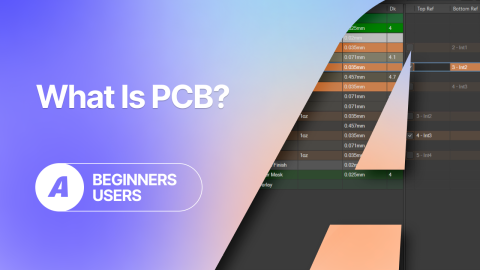Component Information Management in a Unified Design Environment
Selecting components for your PCB device gives it life and should be performed carefully. If you have ever looked for components to use in your PCB, you will find that the list of available components is massive. Each component has a long datasheet that defines its footprint, electrical specifications, pin arrangement, etc. Rather than read through datasheets all day trying to decide which components you need, all this information should be aggregated into a single location in your PCB software.
Great PCB design software has tools available that compile your component information into a single and easy to access library. A component library should do more than just display electrical specifications. Your component library should be integrated into your other design tools. Once you move to manufacturing your device, your component supplier and availability information will ensure that you avoid production delays and unexpected budget changes.
Information Overload
I make many lists as I work on many projects. Keeping track of each project’s information takes time away from actually working. Features like SPICE simulation, bill of materials generation, automated pin-swapping, and rules checking all require accurate component information that can be quickly accessed.
Unfortunately, many PCB design software packages aren’t really sold as complete packages: they separate these features into separate programs. This lack of integration creates a major design bottleneck.
If you update your component libraries, the updated component information should quickly integrate into your other tools. There is no reason you should have to take the time to copy electronic parameters for your components between programs. Improper component information management, especially when working in multiple programs, creates major productivity problems and unnecessary synchronization steps that must be performed manually.
Sourcing in Altium Designer
Realizing Where the Pain Comes From
When your component library is updated, the corresponding updates should appear in your board layout and the schematic. If you don’t choose just the right combination of commands in the program, your components in the layout and schematic may not update at all. You are left experimenting with the interface until it works, or you will have to go through and remove incorrect components manually, and then search through the library to re-add the components.
What’s worse is the inability of libraries to translate when moving between design programs. Two pieces of software from the same company may not be able to read the same library. When you are working with a library that contains thousands of components, this effectively halts design. You are stuck manually translating the library between programs, or you have to purchase a copy of the library for use in your other program.
If you think this is a pain in the neck, wait until you are working with a library full of custom components. If this custom library was created in one program, forget about using it in your other program. You’re now forced to use a pair of design programs that cannot even work together, and you will be stuck manually defining your components for the second time. This creates room for more transcription errors that can be avoided by working in a unified design environment.
Why You Need Integrated Design and Component Management Software
If you are working with separate programs for design, simulation, and component management, you are forced to move between programs while building your device. Repeated imports and exports between programs take extra time and create more potential formatting errors between the two programs. Your tools should automatically synchronize information in your PCB, component libraries, and any other tools that rely on component specifications.
With a unified design environment, updates within one part of the program propagate into the rest of the program without requiring repeated imports and exports. Whether you swap out a component, change your layout, or update your component information, working in a single interface reduces the chances for part referencing errors. Forget about using multiple programs in parallel.
After updating your component library, an integrated software package propagate any library updates back into your board. Your design software should generate a comparison report in an easy-to-read format for your team members. This report should show what was changed for each component, where the component is located, and information should be displayed in progressively finer detail.
The unified design environment in Altium
How Altium’s Design Environment Can Help You
The number of electronic components available on the market is massive and nobody can be expected to memorize everything. When your extensive component libraries are built into your PCB design software, you can spend more time designing a great product and less time scouring the internet for component datasheets. Passing updates from component libraries to your layout and schematic is simple and intuitive.
Altium Designer also has several built-in tools that allow you to simulate the behavior of your device. The component libraries already contain the information you need for SPICE simulations and you can simulate your device performance within a unified design environment. Updates to the components library propagate seamlessly back into your layout and schematic using an intuitive interface.
If you are unsure which components are the best option for your application, don’t be afraid to check the Altium website. Altium maintains a thorough knowledge base that addresses a huge number of design issues, including component selection and data management.
Altium also supports a vibrant community of designers and engineers. Between the AltiumLive forum, video library, user groups, and webinars provided by industry experts, Altium makes sure that you have a support network that can help you succeed as a PCB designer.
A great PCB design software package like Altium Designer can be a major time saver. The integrated design environment and easily accessible component libraries in Altium Designer include all the footprint information, simulation data, and supplier data you need to maximize your productivity. Your component information can be quickly imported into your bill of materials when you are preparing for manufacturing.
You can always download a free trial of the PCB layout software that you want to use for your designs. To find out more about Altium Designer and how its component libraries can save you time designing your next product, talk to an expert at Altium.










 Back
Back